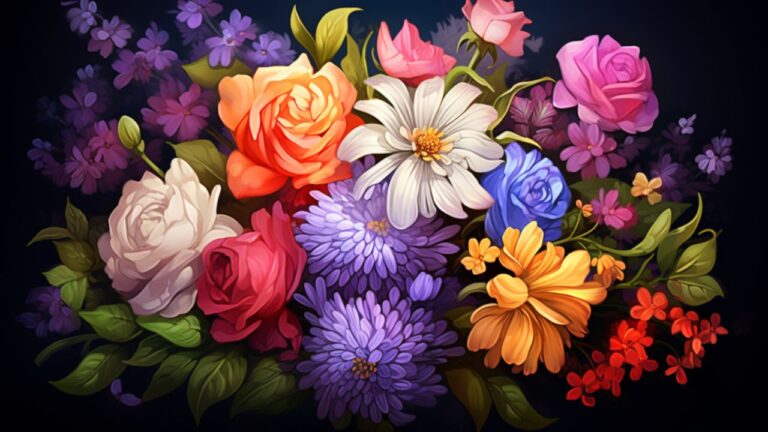
Floriography, commonly referred to as the language of flowers, traces its roots back to ancient civilizations, including the Greeks, Romans, and Egyptians. These cultures recognized the symbolic power of plants and flowers, attributing to them meanings that went beyond mere aesthetics. In these bygone eras, every flower was seen as a secret code, with its own unique message, often associated with myths, folklore, or significant events.
As history unfurled, different regions cultivated their own set of symbolic meanings for various flowers, using them to express emotions and sentiments that might be unsaid, taboo, or simply too profound for words. Flowers became messengers, silently whispering the deepest sentiments of the human heart.
In Victorian England, for instance, floriography reached its peak. During an era where societal norms and strict etiquettes often stifled open expressions of emotions, especially romantic ones, the silent language of flowers thrived. A suitor might send a bouquet of red roses to declare his passionate love or a sprig of forget-me-nots to plead for remembrance.

Over time, the emblematic significance of flowers has grown richer and more varied. They have come to symbolize the breadth and depth of human emotions – from love, passion, and admiration to melancholy, remorse, and even rejection.
Love, in its myriad forms, is most often the sentiment expressed through blooms. Roses, for instance, have universally come to symbolize love. Yet, even within this single category, the myriad of colors convey different shades of affection, passion, and commitment. A single red rose speaks of a love that’s budding, while a bouquet of them declares deep, abiding love. A yellow rose, on the other hand, heralds friendship and joy.
But it’s not just about romance. Flowers speak the language of emotion in its entirety. The purity of a white lily, the cheer brought by bright sunflowers, or the mystery evoked by an exotic orchid – each has a story, a sentiment, an emotion attached.
As we embark on this journey through blossoms and petals, prepare to discover the secrets they hold, the messages they convey, and the undying allure they present in our lives. For in every bloom lies a world of emotion, waiting to be unraveled and understood.
The Romantic period, spanning the late 18th to the early 19th century, was a time of profound change in art, literature, and culture. This era, characterized by its emphasis on emotion, individualism, and nature’s awe, paved the way for the flourishing of floriography. While the language of flowers had ancient roots, it was during the Romantic period that it became an intricate and almost essential art form, especially in Europe.
The Victorian era, nestled within the broader Romantic period, was particularly pivotal. In an age where societal protocols and propriety often hindered the open expression of feelings, especially those of a romantic nature, flowers became the silent bearers of clandestine messages. A suitor couldn’t always voice his affection, but he could certainly send a bouquet filled with symbolism. A red chrysanthemum would mean “I love you,” while a daisy could be sent as a symbol of innocence or purity.
Books dedicated to the language of flowers began to emerge, acting as dictionaries that decoded the meanings of various blossoms. These ‘floral dictionaries’ were popular gifts, especially amongst the young, and they played a crucial role in the courtship rituals of the time.
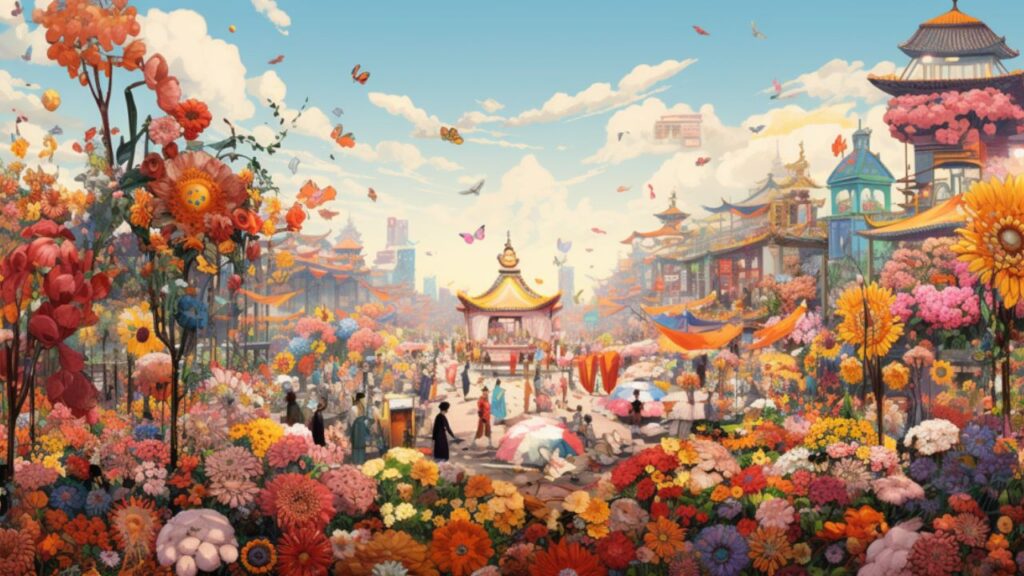
Beyond the bounds of Victorian Europe, the symbolic power of flowers was recognized and celebrated across different cultures and epochs. Here’s a glimpse into the rich tapestry of worldwide floral traditions:
Asia: In countries like China and Japan, flowers have long held deep symbolic meaning. The cherry blossom in Japan, known as ‘sakura,’ is not just an emblem of spring, but also signifies the ephemeral nature of life. In Chinese culture, the peony, with its lush and full bloom, is often associated with riches, honor, and high social status.
Middle East: Flowers like roses and jasmine have played a significant role in Middle Eastern poetry and art for centuries. In ancient Persia (modern-day Iran), roses were a symbol of love and passion, themes that were extensively explored in Persian poetry.
Native American Cultures: Different tribes had their unique sets of meanings for various plants and flowers. For instance, the Plains tribes often used the prairie rose in ceremonies as it symbolized protection.
Ancient Greece and Rome: These ancient civilizations had a pantheon of gods and goddesses associated with various flowers. Aphrodite, the Greek goddess of love, had roses and myrtles dedicated to her, signifying love and beauty. The Romans, borrowing from the Greeks, also incorporated flowers in their myths, ceremonies, and daily life.
These traditions, spanning different continents and ages, emphasize a universal truth: flowers, in their silent beauty, have always been potent messengers, transcending language barriers and cultural differences.
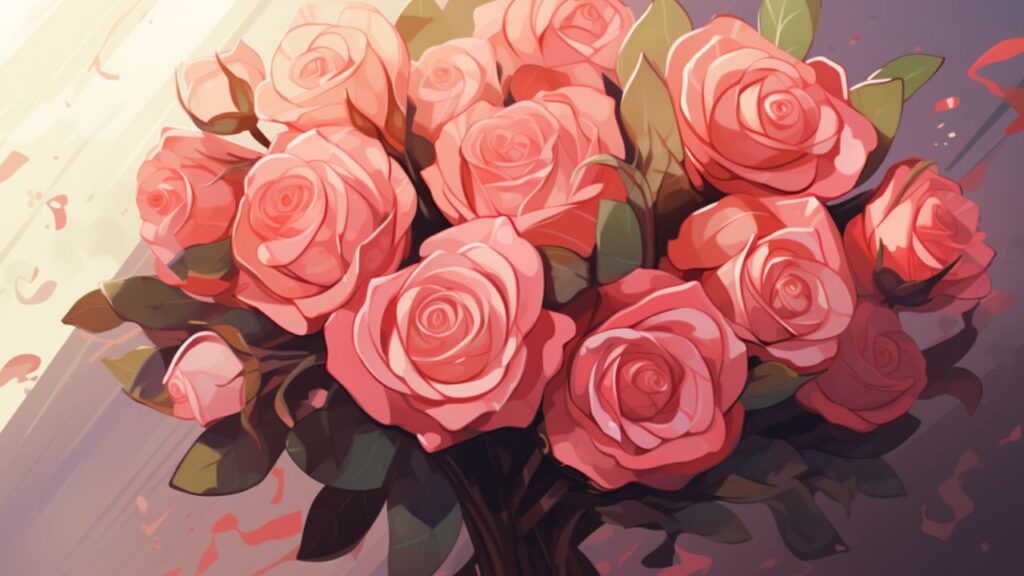
The rose, with its myriad colors and forms, is arguably the most iconic of all flowers when it comes to expressing love. Each shade tells a different tale:
Red Roses: The classic symbol of passionate love and desire. When gifted, they send a clear message of deep affection and admiration.
White Roses: Representing purity, chastity, and innocence, they’re often used in weddings to symbolize the pure love and union of the couple.
Yellow Roses: Initially, they symbolized jealousy but have evolved to represent friendship, joy, and the promise of a new beginning.
Pink Roses: Conveying admiration, gratitude, and joy, pink roses are gentle reminders of affection and are often gifted in appreciation.
Lavender Roses: Representing enchantment and love at first sight, they’re for those magical moments when you’re spellbound by someone.
Lilies are not just a feast for the eyes; they carry profound meanings:
White Lilies: Known for their striking beauty and intoxicating fragrance, they symbolize purity and virtue. Often seen at funerals, they also represent the transience of life and the restored innocence of the soul in the afterlife.
Orange Lilies: Represent passion, confidence, and wealth. Their vibrant hue captures the essence of a burning flame, denoting desire and fervor.
Stargazer Lilies: These pink-spotted blooms signify aspirations and ambitions. They also stand for wealth and prosperity.
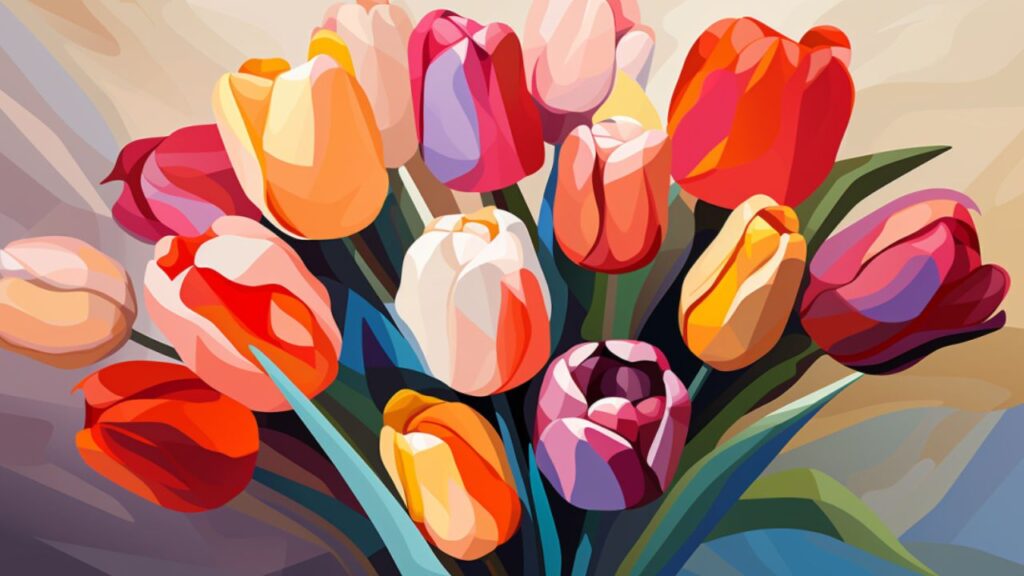
With their simple yet captivating silhouette, tulips have a language of their own:
Red Tulips: A bold declaration of love. They scream, “I love you” and are perfect for expressing deep emotions.
Yellow Tulips: Once signifying hopeless love, their meaning has evolved to represent cheerful thoughts and sunshine.
Purple Tulips: Denote royalty, wealth, and prosperity. They also represent rebirth, being one of the first flowers to bloom in spring.
Daisies, with their cheerful faces, are more than just a symbol of innocence:
White Daisies: Represent purity, true love, and innocence. They embody youthful love and loyal love, making them a sweet gift for a loved one.
Gerbera Daisies: With their vibrant hues, they symbolize cheerfulness. Each color carries a specific meaning, like red for passion and yellow for happiness.
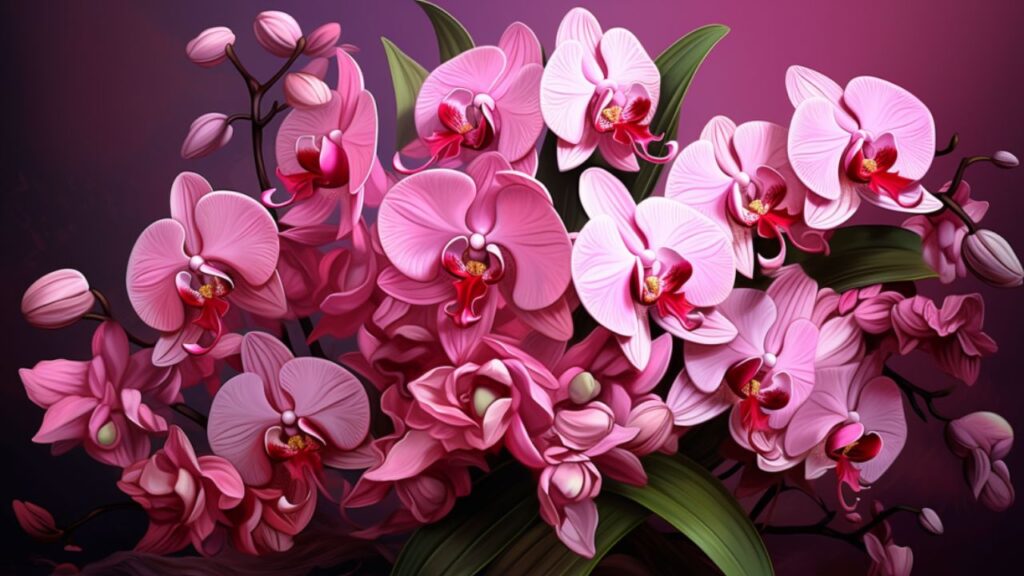
These exotic blooms are a testament to the beauty of the tropics:
White Orchids: Symbolize innocence, purity, and elegance. They’re a popular choice for weddings, given their sophisticated charm.
Purple Orchids: Represent royalty, admiration, and respect. Gifting them can be a gesture of honor and deep reverence.
Pink Orchids: Denote femininity, grace, and joy. They’re perfect for celebrating the women in one’s life.
Yellow Orchids: Symbolize friendship and new beginnings, making them great for housewarmings or congratulating someone on a new endeavor.
In the delicate petals and vibrant hues of these flowers, messages of love, passion, and admiration are whispered, waiting to be understood by those who know the language.
Red, the color of our beating heart, has been universally associated with deep emotions and passionate love. It’s not just restricted to roses; any red flower instantly catches the eye and conveys a message of intense affection, admiration, and desire. The vibrancy of red blooms can spark romantic feelings, making them a popular choice for anniversaries, romantic dates, and Valentine’s Day. Carnations, camellias, and red tulips also fall under this category, each carrying its own nuance but rooted in the overarching theme of love.

White, reminiscent of snow and the soft glow of moonlight, represents purity, innocence, and serenity in the floral world. These flowers are a symbol of untainted love, making them perfect for weddings to represent the pure union of two souls. Beyond the popular white lilies and roses, daisies, gardenias, and white carnations convey similar sentiments. Their pristine beauty resonates with feelings of reverence, making them suitable for solemn occasions too, like funerals, symbolizing the peaceful journey of the soul.
Bright and sunny, yellow flowers are like a splash of sunshine on a gloomy day. They symbolize friendship, joy, and happiness. More than just yellow roses or tulips, sunflowers and daffodils also encapsulate these cheerful emotions. Gifting yellow blooms is a way to celebrate platonic love, strengthen bonds of friendship, or simply bring a smile to someone’s face. They’re a testament to the brighter side of life, representing hope, optimism, and the promise of better days.
Purple, a color often associated with royalty, mystery, and magic, resonates with feelings of admiration and enchantment when it comes to flowers. It’s a hue that captivates the senses, making flowers like lavender, purple orchids, and violets a sight to behold. Purple flowers are often gifted as a sign of respect or to convey a sense of wonder. They strike a balance between the warm affection of red and the calm serenity of blue, making them suitable for various occasions – from romantic gestures to tokens of appreciation.
In the world of flowers, color plays a pivotal role in conveying emotions. Just like a painter uses different shades to bring a canvas to life, the floral palette, with its diverse colors, tells tales of love, friendship, admiration, and so much more. Knowing the language of colors enhances our understanding of these silent messengers, allowing us to pick the perfect bloom for every occasion.
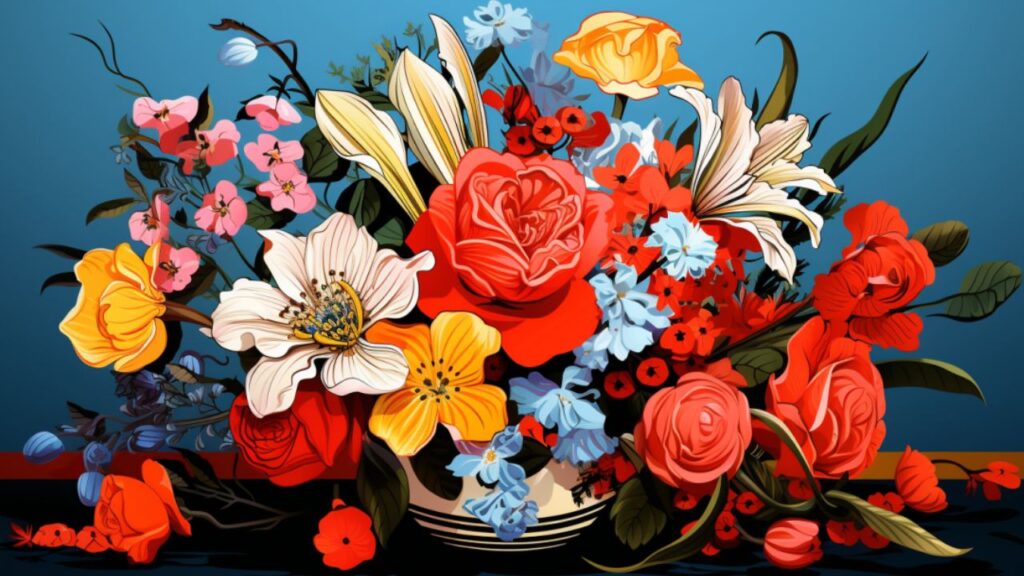
Floral arrangements are more than just randomly placing flowers together. They are a deliberate art form, where each placement, each choice of bloom and leaf, tells a story. The arrangement of a bouquet can amplify the message one wishes to convey, adding layers of depth to the unspoken emotions embedded within.
For centuries, the manner in which flowers were presented held symbolic weight. For instance, flowers presented upside down conveyed the opposite of the flower’s traditional meanings. The height, density, and even the inclusion of other elements like herbs or specific foliage could provide context to the emotions one wished to express. A loosely tied bouquet might symbolize a relationship in its early, free stages, while a more tightly bound one might represent a more committed, intricate bond.
In the intricate language of flowers, combining different blooms allows for the creation of intricate messages, painting a detailed emotional landscape. For example, pairing red roses (passionate love) with daisies (innocent love) could signify a love that is both deep and pure.
There’s also a thoughtful play in contrasts when arranging flowers. Mixing tulips (declaration of love) with yellow chrysanthemums (slighted love) might denote a love that’s experienced both highs and lows but remains steadfast.
Furthermore, the interplay of colors within a bouquet further intensifies its message. A mix of white and red roses could convey unity or a bond that is both pure and passionate. While the inclusion of baby’s breath, often seen as a symbol of everlasting love and purity, can heighten the sentiments of any bouquet it graces.
Moreover, beyond just the choice of flowers, the additional elements in a bouquet – like ferns for sincerity or ivy for fidelity – can enrich the bouquet’s narrative, making it a more intricate and personal token of one’s feelings.
To master the art of sending messages through bouquets, one doesn’t just pick flowers based on their individual meanings but learns to weave them together into a harmonious ensemble, crafting a story of emotions that speaks volumes more than words ever could.
Through the careful art of arrangement, flowers can sing songs of love, sorrow, hope, and countless other emotions, showcasing the depth and breadth of human experience and the bonds we share.

In an age of smartphones and digital communication, the language of flowers has evolved to fit the mediums of the times. One of the most notable incorporations of floral symbolism in today’s digital age is through emojis. These tiny digital icons carry significant emotional weight, much like their real-life counterparts. The rose emoji, for instance, continues to signify love and romance and is often used in romantic exchanges. Similarly, the bouquet emoji can convey gratitude, affection, or congratulations.
Virtual gifting, a phenomenon especially popular in various social media platforms and online games, has also integrated flowers as tokens of appreciation, love, or friendship. Sending a virtual bouquet might not carry the same tactile pleasure as real flowers, but the sentiment remains potent, bridging physical distances with a digital bloom.
This digital adoption of flower language underlines an essential aspect: while methods of communication change, the fundamental human need to convey emotions remains, and flowers, even in digital form, continue to be an evocative medium for that.
Despite the myriad of gift options available in today’s consumer-driven world, flowers remain a classic, go-to choice for expressions of love, especially on occasions like Valentine’s Day and anniversaries. Why do these blooms retain such an esteemed position?
Valentine’s Day, with its roots in various ancient rites celebrating love and fertility, has long been associated with the gifting of flowers, especially red roses, the universal symbol of passionate love. The tradition of gifting flowers on this day serves as a reminder of the timeless nature of love, an emotion that, much like the beauty of a flower, transcends time and remains evergreen.
Anniversaries, marking the milestones in a relationship, are another occasion where flowers hold significant importance. Each year of marriage even has its own designated flower, each representing different facets of a relationship as it grows and evolves. For instance, while the first anniversary is symbolized by the carnation, denoting the ties of joy and commitment, later milestones like the 25th anniversary are represented by the iris, symbolizing the promise and hope of a lasting bond.
The continued prominence of flowers in such celebrations reinforces their enduring relevance in the narrative of love and commitment. They serve as both a testament to the enduring power of traditional symbols and a reflection of the timeless nature of the emotions they represent.
In both the tangible traditions of celebrations and the intangible realm of digital interactions, flowers retain their role as potent symbols, adapting to modern nuances while holding onto their age-old meanings.
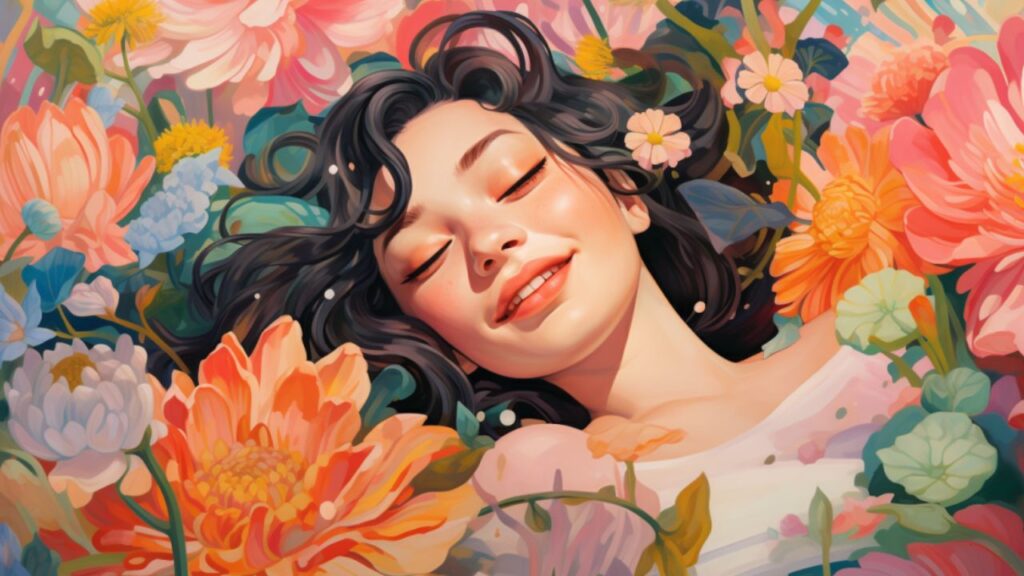
The world of flowers is not just a visual feast; it’s an immersive experience that can profoundly impact our emotional and mental well-being. Floral meditation, or the practice of engaging with flowers mindfully, is a way of channeling this power to foster connection, both with oneself and with others.
To practice floral meditation as a bonding activity:
This practice can be incredibly grounding, and it offers a momentary escape from the hustle and bustle of daily life. By engaging with flowers mindfully, couples can find a shared space of serenity, paving the way for deeper intimacy and understanding.
Scent has always been intrinsically linked to memory and emotion. Floral scents, in particular, possess the unique ability to evoke powerful feelings and can play a pivotal role in enhancing romantic connections.
Harnessing the power of floral scents goes beyond mere olfactory pleasure. It delves into the realm of emotional connections, offering couples a unique way to reminisce, bond, and create new memories imbued with the enchanting world of flowers.

Flowers, in their vibrant hues and varied textures, have always held a special place in the human psyche. Their fleeting beauty, pleasant aroma, and delicate nature often elicit a range of emotions. Delving deeper, one finds that the simple act of gifting or receiving flowers has a profound psychological impact that transcends their aesthetic appeal.
Instant mood enhancer: Multiple studies have shown that receiving flowers can instantly uplift one’s mood. The spontaneous smile that blooms on the recipient’s face is a testament to the happiness and surprise they evoke. This positive emotional response can be attributed to the brain releasing “feel-good” neurotransmitters like dopamine, serotonin, and oxytocin.
Strengthening of bonds: Gifting flowers is not just about the flowers themselves but the emotions and intentions behind them. They symbolize care, appreciation, love, or even apology. As such, they facilitate the expression of feelings that might sometimes be challenging to verbalize, thereby strengthening interpersonal bonds.
Enhancing well-being: Being in the presence of flowers, whether they’re placed on a bedside table or a work desk, has been linked to reduced levels of stress and anxiety. Their natural beauty acts as a reminder of the wonders of nature, providing a momentary escape from the demands of daily life.
Just as the petals of a flower wilt away, moments in life and relationships are transient. However, it’s this very impermanence that adds value and depth to experiences, urging individuals to cherish them.
Embracing the now: Much like a fresh bouquet that demands to be admired in its prime, moments in relationships come with an inherent urgency. They encourage partners to be present, to relish the joy, comfort, or even the challenges of the current moment without undue anticipation of the future or the weight of the past.
Growth through transience: As flowers wither, they give way to seeds, symbolizing the cycle of life and rebirth. Similarly, fleeting moments in relationships, be they of joy, sorrow, or conflict, pave the way for growth, understanding, and deeper connection. They remind couples that, like flowers, relationships too have their seasons, each contributing to the bond’s resilience and depth.
The symbolism of choice: Just as one chooses to water a plant, ensuring its growth, individuals in a relationship choose to nurture their bond daily. The impermanence of flowers serves as a reminder that active effort and care are needed to maintain and flourish a relationship.
In essence, while flowers may be ephemeral, the emotions and lessons they embody are timeless. They serve as poignant reminders to value the present, nurture bonds, and find beauty in transience, lessons that are crucial in fostering meaningful and lasting relationships.

Throughout history, flowers have gracefully woven themselves into the tapestry of human emotions and experiences. From the Ancient Egyptians presenting lotuses as symbols of rebirth to the Victorian-era Europeans exchanging intricate bouquets to convey covert sentiments, flowers have consistently held a revered position in our cultural narratives.
Universal Language: No matter where you travel in the world, flowers are an omnipresent symbol of love, gratitude, and sympathy. Their language transcends geographical boundaries and cultural nuances. The rose, for instance, renowned as the quintessential emblem of love, is celebrated in both Eastern and Western cultures alike.
Evolving, yet Unchanging: While the specific interpretations of flower varieties may shift over time, the core symbolism largely remains consistent. A lily, whether seen in a 16th-century painting or a modern-day bouquet, remains a beacon of purity and renewal.
Emotional Resonance: Perhaps the most captivating aspect of flower symbols is their innate ability to mirror our emotions. From the passionate ardor symbolized by a red tulip to the mournful remembrance evoked by a white chrysanthemum, flowers have this uncanny ability to resonate with our most profound sentiments.
Drawing parallels between nurturing flowers and cultivating a romantic relationship can offer illuminating insights. Both require patience, understanding, and consistent care.
Tending to the Roots: Just as a plant’s health is anchored in its roots, the foundation of a relationship is built on mutual respect, trust, and understanding. Ensuring these elements are robust and healthy can lead to a flourishing bond, much like a well-tended plant.
Adapting to Seasons: Flowers, with their varied blooming seasons, teach us the importance of adaptability. Similarly, relationships go through seasons – phases of passion, tranquility, challenges, and growth. Recognizing and adapting to these phases is crucial for the relationship’s longevity.
Appreciating the Blossoms and the Thorns: Just as a rose is revered for its beauty despite its thorns, a fulfilling relationship is one where both joys and challenges are acknowledged and embraced. It’s in the blend of these experiences that a relationship finds its depth and meaning.
In drawing our journey to a close, let us remember that like flowers, love is delicate yet enduring, requiring both sunshine and rain to blossom. By understanding the timeless language of flowers and applying their wisdom, we can nurture relationships that are as vibrant, beautiful, and resilient as the blooms themselves.
Belinda Balance is a dedicated yoga enthusiast who has integrated the wisdom of ancient practices into modern relationships. Her life revolves around maintaining harmony in all aspects, especially in love and companionship. She believes that just like our bodies, relationships require balance, flexibility, and a lot of practice to stay healthy.
Belinda has dedicated her life to teaching others about the importance of mindfulness in relationships, often drawing parallels between the discipline required in yoga and the commitment necessary in relationships.